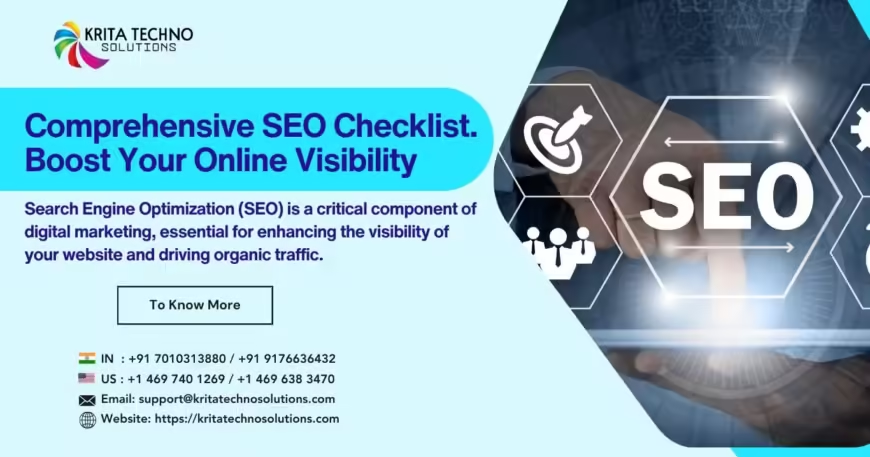Search Engine Optimization (SEO) is a critical component of digital marketing, essential for enhancing the visibility of your website and driving organic traffic. This comprehensive SEO checklist will guide you through the essential steps to optimize your website effectively. Whether you’re a beginner or an experienced marketer, this checklist will help you cover all the bases.
With 12+ years of experience in the industry and a wealth of knowledge about the latest Web technologies, media trends and best practices, we are well-equipped to help you achieve your marketing goals.
1. Keyword Research
Identify Relevant Keywords
Use tools like Google Keyword Planner, Ahrefs, or SEMrush to find keywords relevant to your business.
Focus on long-tail keywords that are less competitive but highly relevant.
Analyze Competitors
Identify the keywords your competitors are ranking for.
Use tools like Ahrefs or SEMrush to analyze their keyword strategy.
2. On-Page SEO
Title Tags and Meta Descriptions
Ensure each page has a unique and compelling title tag (50-60 characters).
Write meta descriptions (150-160 characters) that include your target keywords and entice users to click.
Header Tags
Use header tags (H1, H2, H3, etc.) to structure your content logically.
Ensure the H1 tag includes the primary keyword and clearly defines the topic.
Content Optimization
Produce high-quality, original content that provides value to your audience.
Use your target keywords naturally within the content, aiming for a keyword density of 1-2%.
Include internal and external links to relevant content.
Image Optimization
Use descriptive file names and alt tags for all images.
Compress images to improve page load speed without sacrificing quality.
3. Technical SEO
Website Speed
Use tools like Google PageSpeed Insights or GTmetrix to check your website’s speed.
Optimize images, leverage browser caching, and minimize CSS, JavaScript, and HTML.
Mobile-Friendliness
Ensure your website is mobile-friendly using Google’s Mobile-Friendly Test.
Implement a responsive design that adjusts to different screen sizes.
XML Sitemap
Create an XML sitemap and submit it to Google Search Console.
Ensure the sitemap is updated regularly as you add new content.
Robots.txt File
Use the robots.txt file to guide search engine crawlers on which pages to index.
Ensure that critical pages are not accidentally blocked.
4. Off-Page SEO
Backlink Building
Acquire high-quality backlinks from reputable websites.
Use techniques such as guest blogging, influencer outreach, and content marketing.
Social Signals
Promote your content on social media platforms to increase visibility and engagement.
Encourage social sharing by adding social sharing buttons to your content.
Online Directories and Citations
List your business in relevant online directories and ensure your information is consistent.
Focus on high-authority directories like Google My Business, Yelp, and Bing Places.
5. Local SEO
Google My Business
Claim and optimize your Google My Business listing.
Ensure your business name, address, and phone number (NAP) are accurate and consistent.
Local Keywords
Use local keywords in your content and meta tags to attract local traffic.
Create location-specific landing pages if you operate in multiple locations.
Reviews and Ratings
Encourage satisfied customers to leave positive reviews on Google and other review platforms.
Respond to reviews, both positive and negative, to show you value customer feedback.
6. Monitoring and Analytics
Google Analytics
Set up Google Analytics to track your website’s performance.
Monitor key metrics such as organic traffic, bounce rate, and average session duration.
Google Search Console
Use Google Search Console to monitor your site’s search performance.
Track keyword rankings, identify crawl errors, and submit sitemaps.
Regular Audits
Conduct regular SEO audits to identify and fix any issues.
Use tools like Screaming Frog, Ahrefs, or SEMrush for comprehensive audits.
SEO is an ongoing process that requires continuous effort and adaptation. By following this comprehensive SEO checklist, you can ensure that your website is well-optimized and positioned to achieve higher search engine rankings. Stay updated with the latest SEO trends and algorithm changes to maintain and improve your online visibility. Happy optimizing!
Contact us :
📞 IN : +91 7010313880 / +91 9176636432
📞 US : +1 469 740 1269 / +1 214 705 2058
✉️ Email: support@kritatechnosolutions.com
🌐 Website: https://kritatechnosolutions.com/






